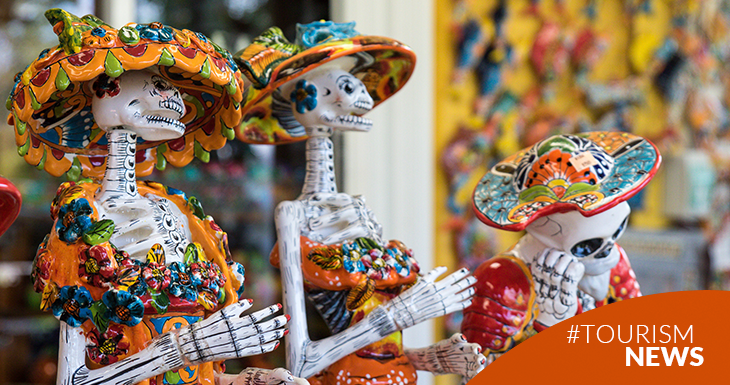Today we travel to Mexico - the country where we provide our services, among others - to tell you about the traditional celebration of the Day of the Dead, a ritual that privileges memory over oblivion.
It should be noted that the festival is considered by UNESCO as Intangible Cultural Heritage of Humanity since 2008; Furthermore, it is a symbol of national identity for Mexicans.
What is the origin of this very particular tradition?
The Day of the Dead has been celebrated in Mexico since before the arrival of the Spanish. In fact, it was a celebration common to all Mesoamerican cultures that had a similar concept of death and its meaning. In these cultures the fate of the dead was marked by the way of life that the person had. With the arrival of the Spanish, the party became mestizo and added new Catholic elements and meanings. The flower cross is the most significant of these elements.
What is evoked during these days?
The celebration takes place on November 1 and 2, although it usually begins on the night of October 31 when the first candles are lit to receive the dead children, since November 1 is All Saints' Day.
They pray and in some areas of the country they spend the night in cemeteries. At the end of the celebration, all the dishes and drinks that were brought for the occasion are tasted. Many families place offerings and decorated altars, papel picado, sugar skulls, bread of the dead, mole or some dish that their relatives liked to whom the offering is dedicated to, and as in pre-Hispanic times, the incense perfumes it.
Tradition also indicates that, in order to facilitate the return of souls to earth, marigold flower petals should be spread and candles placed tracing the path they are going to travel so that the souls do not get lost and reach their destination. In ancient times, this path led from the family home to the pantheon where their loved ones rest.
Meaning of this date for Catholicism and pre-Hispanic peoples:
The Day of the Dead unites two very different worldviews: from the Catholic religion it is a date to pray for souls in pain, which remains in that state until they have paid for their sins. For this reason, for Catholicism the idea of the return of the dead is not conceived as such. For the pre-Hispanic peoples, on the other hand, life and death were part of the process that all human beings went through, ceasing to live did not mean ceasing to exist. According to tradition, loved ones who have passed away return to be with their relatives and nourish themselves from the offerings placed in their honor. For the living it is an opportunity for recognition and prayer, for reflection on death.
Did you know how the picturesque and crowded Day of the Dead parade came about?
The person in charge of the massive parade is nothing more and nothing less than James Bond. In the movie "007: Specter" - released in 2015 and starring Daniel Craig - the agent chases a villain in the middle of the crowd who enjoys a parade of people dressed in skeleton costumes to celebrate the Day of the Dead.
For the filming, its director Sam Mandes chose to start the character's journey in the center of Mexico City precisely on the Day of the Dead. For this event, Mexican artists were hired who created the floats with the respective catrinas, more than a thousand actors, dancers and acrobats, who delighted the public with their brief participation in the film.
This scene was so unforgettable, and it captured the attention of the public, that the Mexican government authorities chose to take up the idea and turn it into a new tradition that, from 2016 to this day, has been carried out.
This 2021, the parade will start in Campo Marte, located in the Polanco area, Chapultepec in Mexico City and will end in the Plaza de la Constitución, and will honor the people who died due to Covid-19. For this reason the parade will be called "Celebrating life.".


